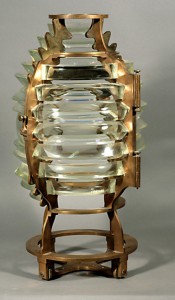Lighthouse Lens
 From funds appropriated from Congress in 1837, Milwaukee’s first lighthouse was erected on the large bluff at the east end of Wisconsin Street (today’s East Wisconsin Avenue), on land donated by Solomon Juneau. Built in 1838, the lighthouse was 50 feet high, including a 10-foot lantern house on top. There was a picket fence around the base, and the keeper’s house stood close by. In 1839, The Milwaukee Sentinel told its readers this bluff, called “Bates’ Bluff” by the newspaper, was one of the most romantic spots in the city: “On a bright, calm summer’s evening nothing can be more delightful than the view of the lake from the bluff.”
From funds appropriated from Congress in 1837, Milwaukee’s first lighthouse was erected on the large bluff at the east end of Wisconsin Street (today’s East Wisconsin Avenue), on land donated by Solomon Juneau. Built in 1838, the lighthouse was 50 feet high, including a 10-foot lantern house on top. There was a picket fence around the base, and the keeper’s house stood close by. In 1839, The Milwaukee Sentinel told its readers this bluff, called “Bates’ Bluff” by the newspaper, was one of the most romantic spots in the city: “On a bright, calm summer’s evening nothing can be more delightful than the view of the lake from the bluff.”
This lighthouse served Milwaukee until November 1855, when it was replaced by the new North Point Light House, located in Lake Park. Shortly after being replaced the old lighthouse and the keeper’s dwelling on Wisconsin Street were put up for auction. E.M. Shoyer & Co. purchased the buildings for $860, intending to use the materials in constructing a new wholesale clothing store on North Water Street.
The Fresnel lens (pronounced frey-NELL) in the Historical Society’s collection is from this first lighthouse at the foot of East Wisconsin Avenue. The lens was developed by French physicist Augustin-Jean Fresnel for lighthouses, and first used in 1823. The design enables the construction of lenses of large aperture and short local length without the weight and volume of material that would be required in conventional lens design. This lens design allowed lighthouses to be visible over much longer distances.
Eli Bates was the keeper of Milwaukee’s first lighthouse. A former school teacher, he was hired at a salary of $300 a year in 1838 and added to this income by keeping a gingerbread and small beer stand in an apartment of the whitewashed brick house provided as a residence. Bates was commonly called “Cork Leg” due to his having one leg of that material. A well liked, outgoing man, it was quipped by early Milwaukeeans that “the seven lanterns which hung in the lantern house were not all that was lit nightly, for cork legged Eli Bates, the keeper, had always a table or two of the gayest young blades in town playing cards and bending elbows until the dawn. “
After his job as Milwaukee’s light keeper, Bates went to Chicago and established a business there, eventually ranking as one of that city’s millionaires. Eli Bates did much charity work in Chicago. He left a large amount of money to philanthropic projects in Chicago. He bequeathed $40,000 for the purpose of erecting a monument to President Lincoln at the entrance to Lincoln Park, in addition to giving $15,000 for the building of a fountain in the same park. He left $20,000 for the completion of Chicago’s Unity Church and $25,000 to the city’s industrial school.
